Entrepreneurship Analysis: Footsteps Company Case Study and Strategy
VerifiedAdded on 2023/01/13
|11
|4141
|94
Case Study
AI Summary
This case study analyzes the Footsteps Company, a historical tour business run by Roger and Judith Ironidge, examining their entrepreneurial roles, the overlap of family and business, and strategic planning. The analysis explores the strengths and weaknesses of family members, intergenerational transitions, opportunities and constraints related to business growth, and the evidence of strategic thinking. The case study highlights Roger's reluctance towards the business's logistical aspects, Judith's administrative burdens, and the involvement of their daughter, Isabella, who brings in new perspectives. The study also addresses governmental policies and organizations that support small firms, offering a comprehensive overview of the challenges and opportunities faced by the Footsteps Company as it navigates its business and family dynamics.
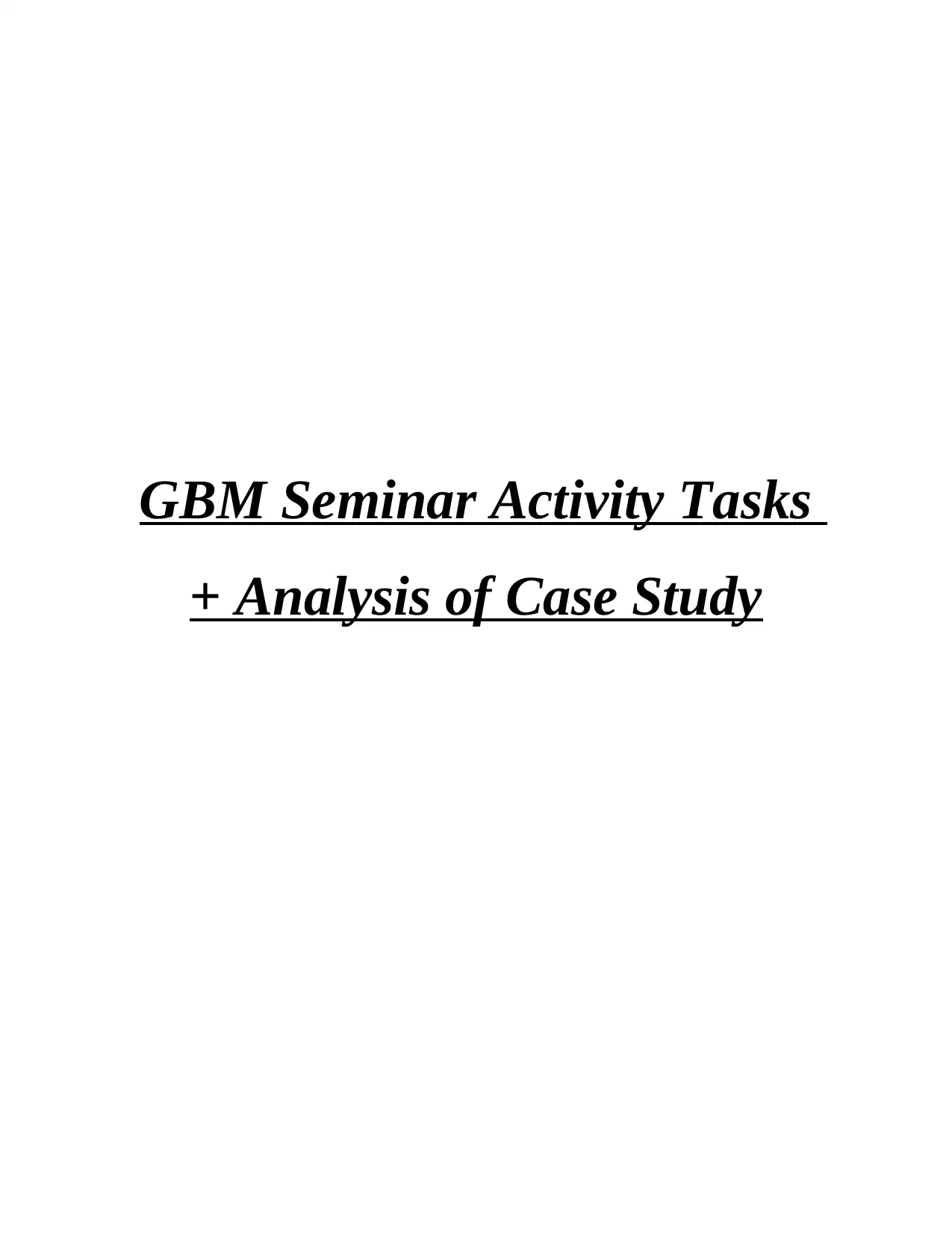
GBM Seminar Activity Tasks
+ Analysis of Case Study
+ Analysis of Case Study
Paraphrase This Document
Need a fresh take? Get an instant paraphrase of this document with our AI Paraphraser
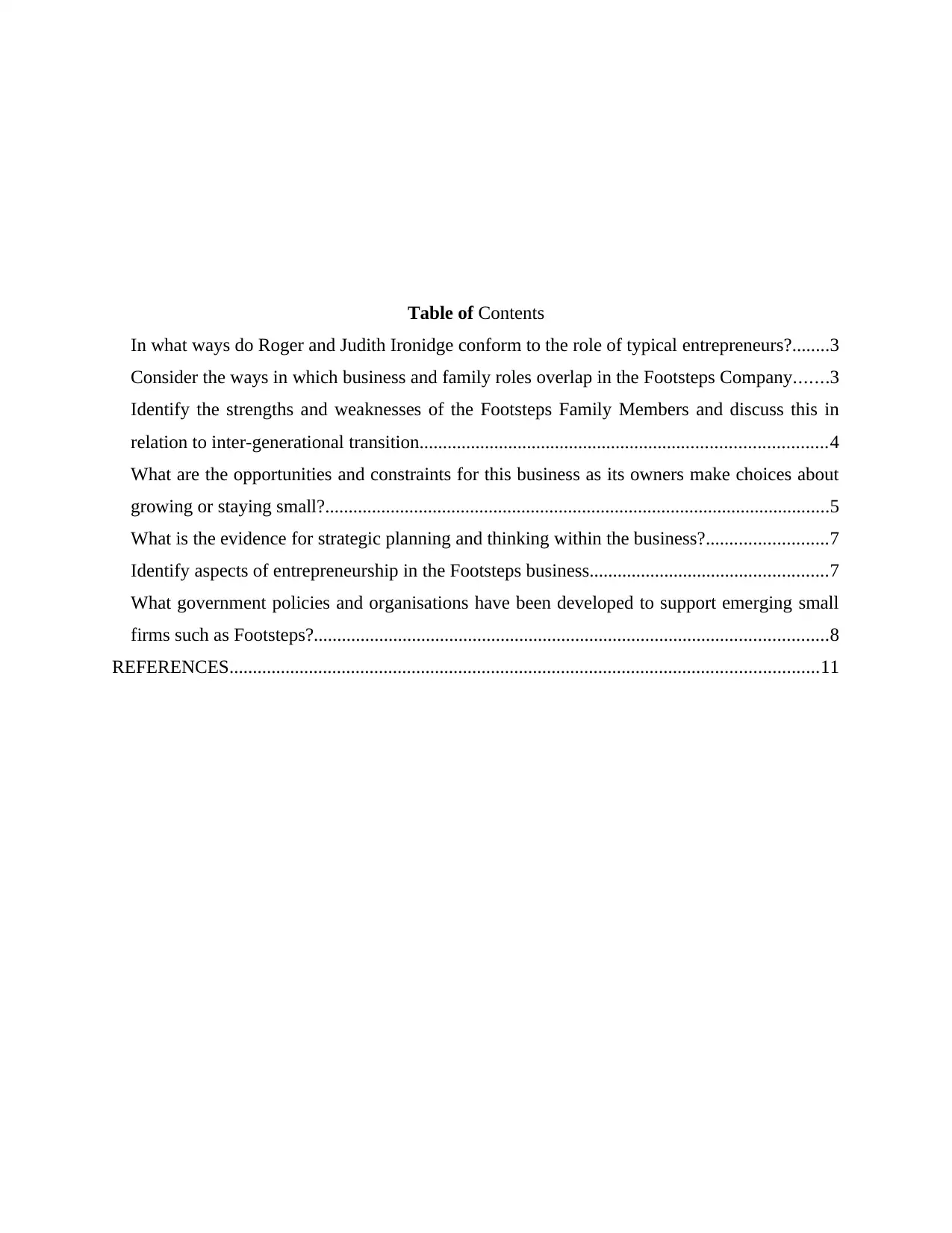
Table of Contents
In what ways do Roger and Judith Ironidge conform to the role of typical entrepreneurs?........3
Consider the ways in which business and family roles overlap in the Footsteps Company.......3
Identify the strengths and weaknesses of the Footsteps Family Members and discuss this in
relation to inter-generational transition.......................................................................................4
What are the opportunities and constraints for this business as its owners make choices about
growing or staying small?............................................................................................................5
What is the evidence for strategic planning and thinking within the business?..........................7
Identify aspects of entrepreneurship in the Footsteps business...................................................7
What government policies and organisations have been developed to support emerging small
firms such as Footsteps?..............................................................................................................8
REFERENCES..............................................................................................................................11
In what ways do Roger and Judith Ironidge conform to the role of typical entrepreneurs?........3
Consider the ways in which business and family roles overlap in the Footsteps Company.......3
Identify the strengths and weaknesses of the Footsteps Family Members and discuss this in
relation to inter-generational transition.......................................................................................4
What are the opportunities and constraints for this business as its owners make choices about
growing or staying small?............................................................................................................5
What is the evidence for strategic planning and thinking within the business?..........................7
Identify aspects of entrepreneurship in the Footsteps business...................................................7
What government policies and organisations have been developed to support emerging small
firms such as Footsteps?..............................................................................................................8
REFERENCES..............................................................................................................................11
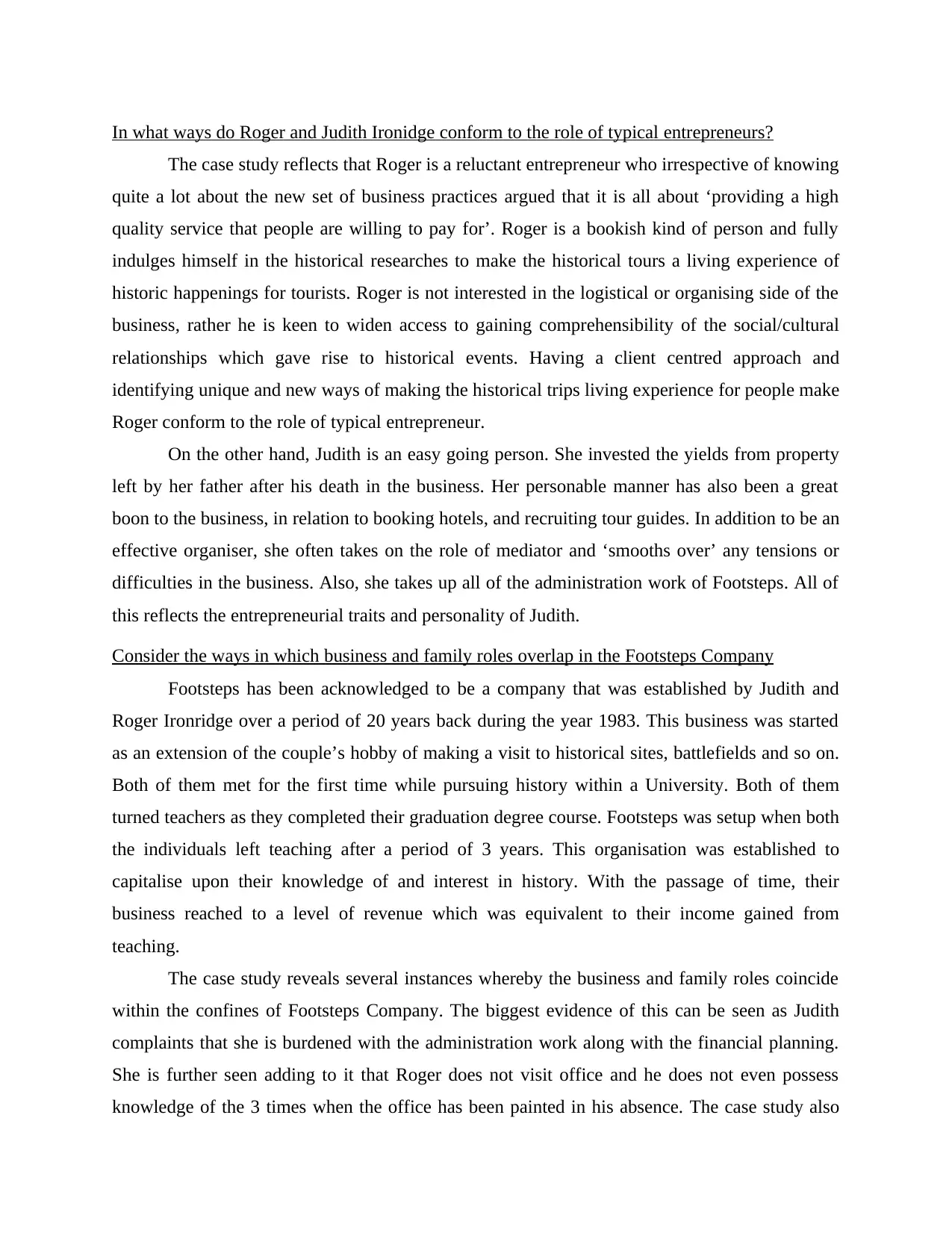
In what ways do Roger and Judith Ironidge conform to the role of typical entrepreneurs?
The case study reflects that Roger is a reluctant entrepreneur who irrespective of knowing
quite a lot about the new set of business practices argued that it is all about ‘providing a high
quality service that people are willing to pay for’. Roger is a bookish kind of person and fully
indulges himself in the historical researches to make the historical tours a living experience of
historic happenings for tourists. Roger is not interested in the logistical or organising side of the
business, rather he is keen to widen access to gaining comprehensibility of the social/cultural
relationships which gave rise to historical events. Having a client centred approach and
identifying unique and new ways of making the historical trips living experience for people make
Roger conform to the role of typical entrepreneur.
On the other hand, Judith is an easy going person. She invested the yields from property
left by her father after his death in the business. Her personable manner has also been a great
boon to the business, in relation to booking hotels, and recruiting tour guides. In addition to be an
effective organiser, she often takes on the role of mediator and ‘smooths over’ any tensions or
difficulties in the business. Also, she takes up all of the administration work of Footsteps. All of
this reflects the entrepreneurial traits and personality of Judith.
Consider the ways in which business and family roles overlap in the Footsteps Company
Footsteps has been acknowledged to be a company that was established by Judith and
Roger Ironridge over a period of 20 years back during the year 1983. This business was started
as an extension of the couple’s hobby of making a visit to historical sites, battlefields and so on.
Both of them met for the first time while pursuing history within a University. Both of them
turned teachers as they completed their graduation degree course. Footsteps was setup when both
the individuals left teaching after a period of 3 years. This organisation was established to
capitalise upon their knowledge of and interest in history. With the passage of time, their
business reached to a level of revenue which was equivalent to their income gained from
teaching.
The case study reveals several instances whereby the business and family roles coincide
within the confines of Footsteps Company. The biggest evidence of this can be seen as Judith
complaints that she is burdened with the administration work along with the financial planning.
She is further seen adding to it that Roger does not visit office and he does not even possess
knowledge of the 3 times when the office has been painted in his absence. The case study also
The case study reflects that Roger is a reluctant entrepreneur who irrespective of knowing
quite a lot about the new set of business practices argued that it is all about ‘providing a high
quality service that people are willing to pay for’. Roger is a bookish kind of person and fully
indulges himself in the historical researches to make the historical tours a living experience of
historic happenings for tourists. Roger is not interested in the logistical or organising side of the
business, rather he is keen to widen access to gaining comprehensibility of the social/cultural
relationships which gave rise to historical events. Having a client centred approach and
identifying unique and new ways of making the historical trips living experience for people make
Roger conform to the role of typical entrepreneur.
On the other hand, Judith is an easy going person. She invested the yields from property
left by her father after his death in the business. Her personable manner has also been a great
boon to the business, in relation to booking hotels, and recruiting tour guides. In addition to be an
effective organiser, she often takes on the role of mediator and ‘smooths over’ any tensions or
difficulties in the business. Also, she takes up all of the administration work of Footsteps. All of
this reflects the entrepreneurial traits and personality of Judith.
Consider the ways in which business and family roles overlap in the Footsteps Company
Footsteps has been acknowledged to be a company that was established by Judith and
Roger Ironridge over a period of 20 years back during the year 1983. This business was started
as an extension of the couple’s hobby of making a visit to historical sites, battlefields and so on.
Both of them met for the first time while pursuing history within a University. Both of them
turned teachers as they completed their graduation degree course. Footsteps was setup when both
the individuals left teaching after a period of 3 years. This organisation was established to
capitalise upon their knowledge of and interest in history. With the passage of time, their
business reached to a level of revenue which was equivalent to their income gained from
teaching.
The case study reveals several instances whereby the business and family roles coincide
within the confines of Footsteps Company. The biggest evidence of this can be seen as Judith
complaints that she is burdened with the administration work along with the financial planning.
She is further seen adding to it that Roger does not visit office and he does not even possess
knowledge of the 3 times when the office has been painted in his absence. The case study also
⊘ This is a preview!⊘
Do you want full access?
Subscribe today to unlock all pages.

Trusted by 1+ million students worldwide
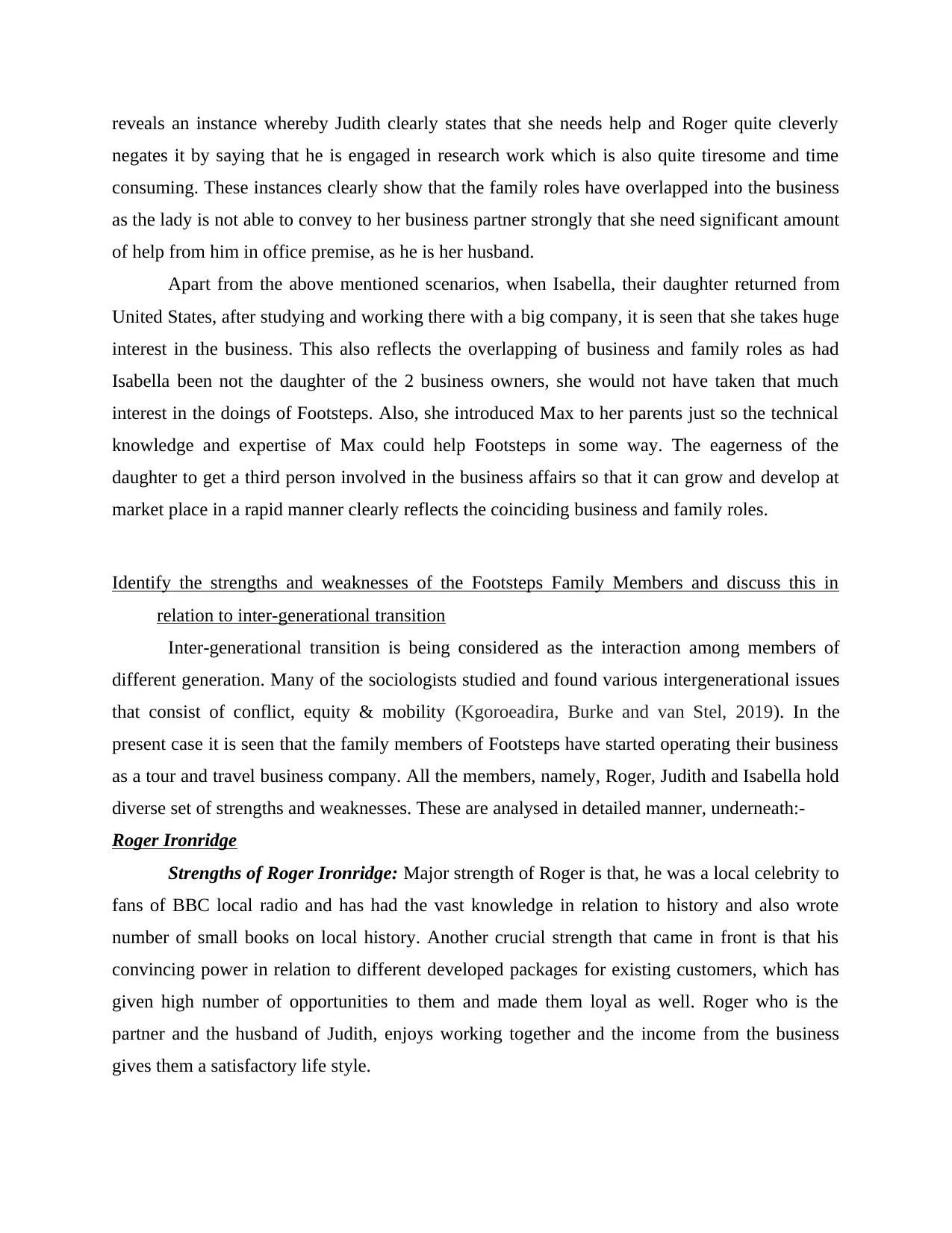
reveals an instance whereby Judith clearly states that she needs help and Roger quite cleverly
negates it by saying that he is engaged in research work which is also quite tiresome and time
consuming. These instances clearly show that the family roles have overlapped into the business
as the lady is not able to convey to her business partner strongly that she need significant amount
of help from him in office premise, as he is her husband.
Apart from the above mentioned scenarios, when Isabella, their daughter returned from
United States, after studying and working there with a big company, it is seen that she takes huge
interest in the business. This also reflects the overlapping of business and family roles as had
Isabella been not the daughter of the 2 business owners, she would not have taken that much
interest in the doings of Footsteps. Also, she introduced Max to her parents just so the technical
knowledge and expertise of Max could help Footsteps in some way. The eagerness of the
daughter to get a third person involved in the business affairs so that it can grow and develop at
market place in a rapid manner clearly reflects the coinciding business and family roles.
Identify the strengths and weaknesses of the Footsteps Family Members and discuss this in
relation to inter-generational transition
Inter-generational transition is being considered as the interaction among members of
different generation. Many of the sociologists studied and found various intergenerational issues
that consist of conflict, equity & mobility (Kgoroeadira, Burke and van Stel, 2019). In the
present case it is seen that the family members of Footsteps have started operating their business
as a tour and travel business company. All the members, namely, Roger, Judith and Isabella hold
diverse set of strengths and weaknesses. These are analysed in detailed manner, underneath:-
Roger Ironridge
Strengths of Roger Ironridge: Major strength of Roger is that, he was a local celebrity to
fans of BBC local radio and has had the vast knowledge in relation to history and also wrote
number of small books on local history. Another crucial strength that came in front is that his
convincing power in relation to different developed packages for existing customers, which has
given high number of opportunities to them and made them loyal as well. Roger who is the
partner and the husband of Judith, enjoys working together and the income from the business
gives them a satisfactory life style.
negates it by saying that he is engaged in research work which is also quite tiresome and time
consuming. These instances clearly show that the family roles have overlapped into the business
as the lady is not able to convey to her business partner strongly that she need significant amount
of help from him in office premise, as he is her husband.
Apart from the above mentioned scenarios, when Isabella, their daughter returned from
United States, after studying and working there with a big company, it is seen that she takes huge
interest in the business. This also reflects the overlapping of business and family roles as had
Isabella been not the daughter of the 2 business owners, she would not have taken that much
interest in the doings of Footsteps. Also, she introduced Max to her parents just so the technical
knowledge and expertise of Max could help Footsteps in some way. The eagerness of the
daughter to get a third person involved in the business affairs so that it can grow and develop at
market place in a rapid manner clearly reflects the coinciding business and family roles.
Identify the strengths and weaknesses of the Footsteps Family Members and discuss this in
relation to inter-generational transition
Inter-generational transition is being considered as the interaction among members of
different generation. Many of the sociologists studied and found various intergenerational issues
that consist of conflict, equity & mobility (Kgoroeadira, Burke and van Stel, 2019). In the
present case it is seen that the family members of Footsteps have started operating their business
as a tour and travel business company. All the members, namely, Roger, Judith and Isabella hold
diverse set of strengths and weaknesses. These are analysed in detailed manner, underneath:-
Roger Ironridge
Strengths of Roger Ironridge: Major strength of Roger is that, he was a local celebrity to
fans of BBC local radio and has had the vast knowledge in relation to history and also wrote
number of small books on local history. Another crucial strength that came in front is that his
convincing power in relation to different developed packages for existing customers, which has
given high number of opportunities to them and made them loyal as well. Roger who is the
partner and the husband of Judith, enjoys working together and the income from the business
gives them a satisfactory life style.
Paraphrase This Document
Need a fresh take? Get an instant paraphrase of this document with our AI Paraphraser
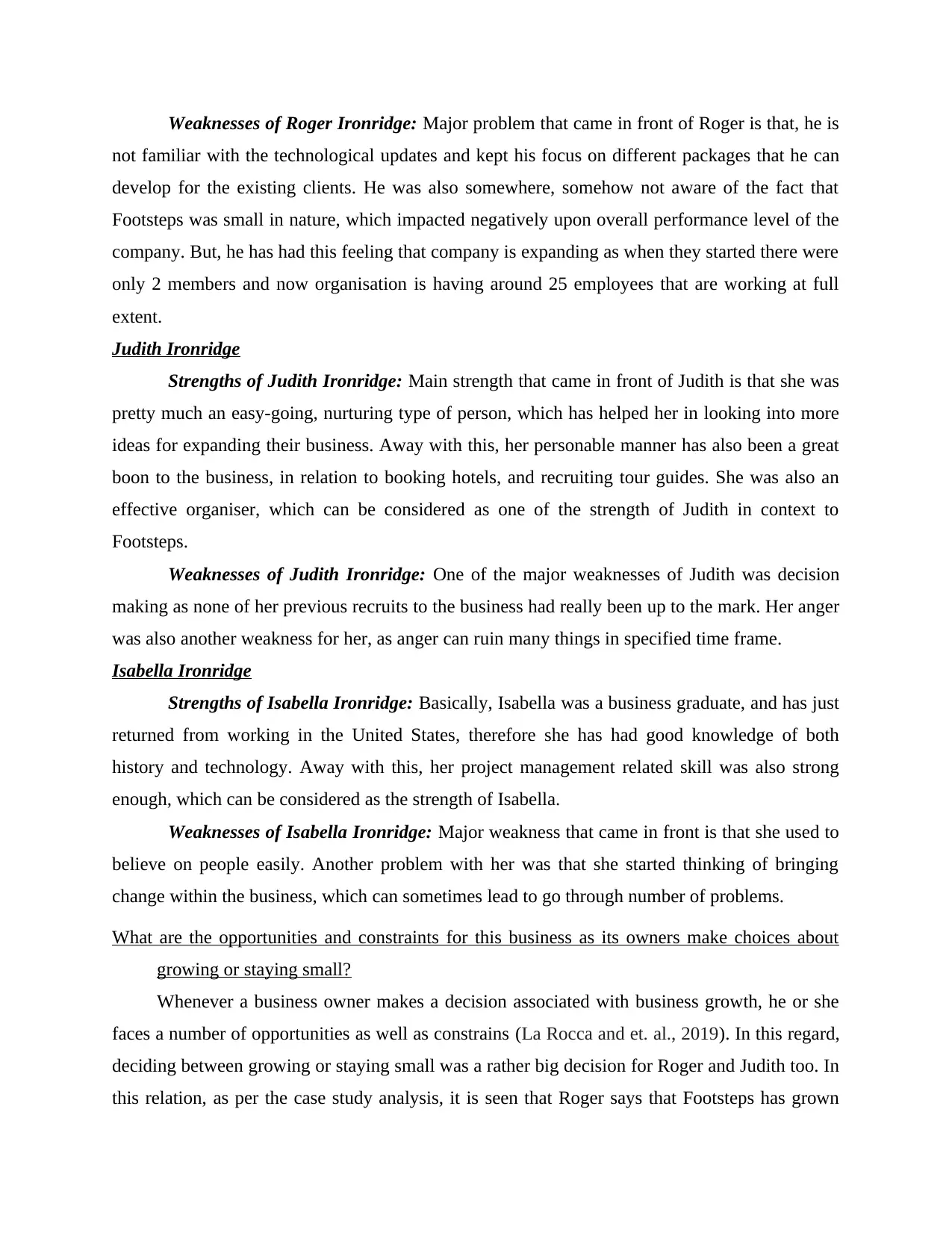
Weaknesses of Roger Ironridge: Major problem that came in front of Roger is that, he is
not familiar with the technological updates and kept his focus on different packages that he can
develop for the existing clients. He was also somewhere, somehow not aware of the fact that
Footsteps was small in nature, which impacted negatively upon overall performance level of the
company. But, he has had this feeling that company is expanding as when they started there were
only 2 members and now organisation is having around 25 employees that are working at full
extent.
Judith Ironridge
Strengths of Judith Ironridge: Main strength that came in front of Judith is that she was
pretty much an easy-going, nurturing type of person, which has helped her in looking into more
ideas for expanding their business. Away with this, her personable manner has also been a great
boon to the business, in relation to booking hotels, and recruiting tour guides. She was also an
effective organiser, which can be considered as one of the strength of Judith in context to
Footsteps.
Weaknesses of Judith Ironridge: One of the major weaknesses of Judith was decision
making as none of her previous recruits to the business had really been up to the mark. Her anger
was also another weakness for her, as anger can ruin many things in specified time frame.
Isabella Ironridge
Strengths of Isabella Ironridge: Basically, Isabella was a business graduate, and has just
returned from working in the United States, therefore she has had good knowledge of both
history and technology. Away with this, her project management related skill was also strong
enough, which can be considered as the strength of Isabella.
Weaknesses of Isabella Ironridge: Major weakness that came in front is that she used to
believe on people easily. Another problem with her was that she started thinking of bringing
change within the business, which can sometimes lead to go through number of problems.
What are the opportunities and constraints for this business as its owners make choices about
growing or staying small?
Whenever a business owner makes a decision associated with business growth, he or she
faces a number of opportunities as well as constrains (La Rocca and et. al., 2019). In this regard,
deciding between growing or staying small was a rather big decision for Roger and Judith too. In
this relation, as per the case study analysis, it is seen that Roger says that Footsteps has grown
not familiar with the technological updates and kept his focus on different packages that he can
develop for the existing clients. He was also somewhere, somehow not aware of the fact that
Footsteps was small in nature, which impacted negatively upon overall performance level of the
company. But, he has had this feeling that company is expanding as when they started there were
only 2 members and now organisation is having around 25 employees that are working at full
extent.
Judith Ironridge
Strengths of Judith Ironridge: Main strength that came in front of Judith is that she was
pretty much an easy-going, nurturing type of person, which has helped her in looking into more
ideas for expanding their business. Away with this, her personable manner has also been a great
boon to the business, in relation to booking hotels, and recruiting tour guides. She was also an
effective organiser, which can be considered as one of the strength of Judith in context to
Footsteps.
Weaknesses of Judith Ironridge: One of the major weaknesses of Judith was decision
making as none of her previous recruits to the business had really been up to the mark. Her anger
was also another weakness for her, as anger can ruin many things in specified time frame.
Isabella Ironridge
Strengths of Isabella Ironridge: Basically, Isabella was a business graduate, and has just
returned from working in the United States, therefore she has had good knowledge of both
history and technology. Away with this, her project management related skill was also strong
enough, which can be considered as the strength of Isabella.
Weaknesses of Isabella Ironridge: Major weakness that came in front is that she used to
believe on people easily. Another problem with her was that she started thinking of bringing
change within the business, which can sometimes lead to go through number of problems.
What are the opportunities and constraints for this business as its owners make choices about
growing or staying small?
Whenever a business owner makes a decision associated with business growth, he or she
faces a number of opportunities as well as constrains (La Rocca and et. al., 2019). In this regard,
deciding between growing or staying small was a rather big decision for Roger and Judith too. In
this relation, as per the case study analysis, it is seen that Roger says that Footsteps has grown
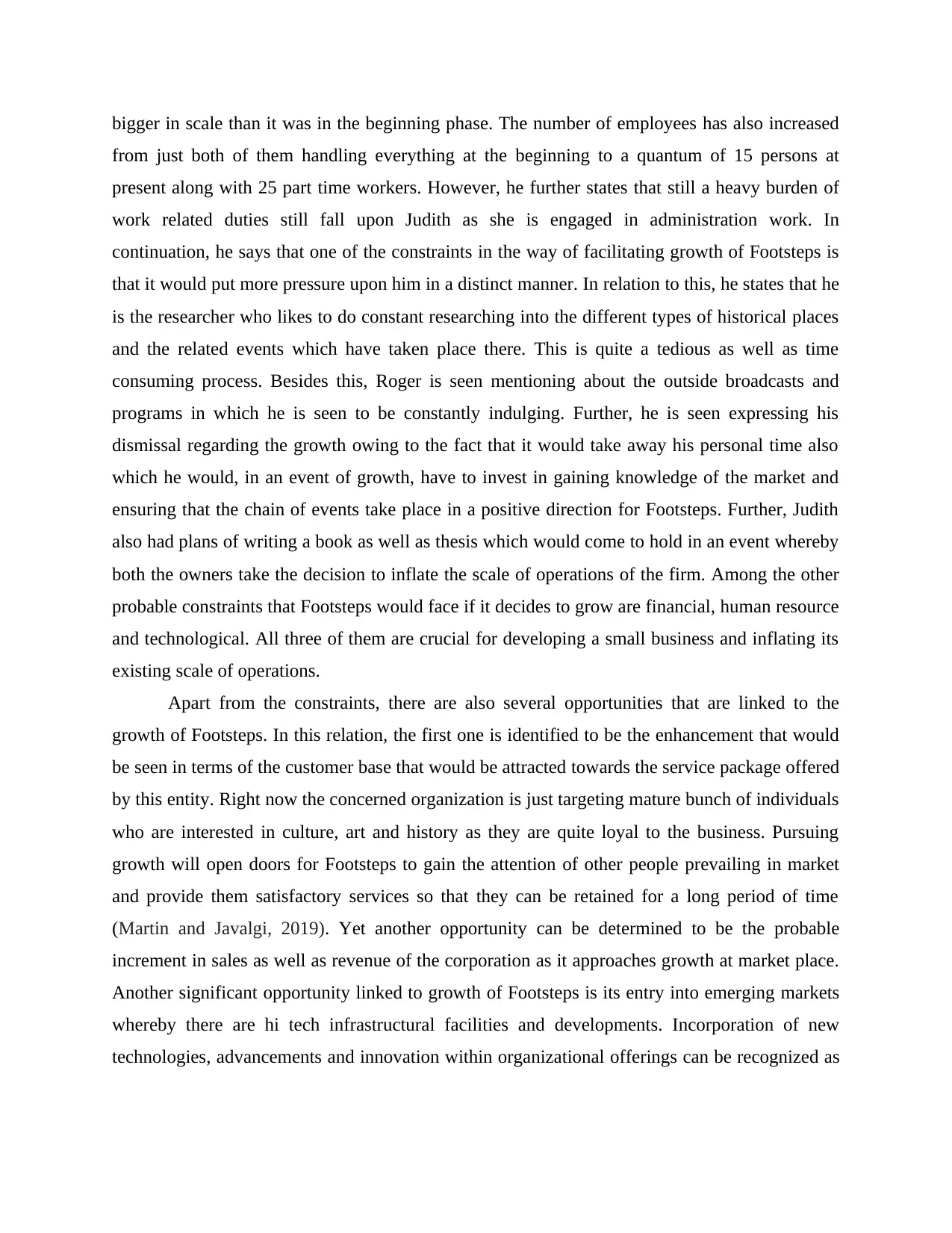
bigger in scale than it was in the beginning phase. The number of employees has also increased
from just both of them handling everything at the beginning to a quantum of 15 persons at
present along with 25 part time workers. However, he further states that still a heavy burden of
work related duties still fall upon Judith as she is engaged in administration work. In
continuation, he says that one of the constraints in the way of facilitating growth of Footsteps is
that it would put more pressure upon him in a distinct manner. In relation to this, he states that he
is the researcher who likes to do constant researching into the different types of historical places
and the related events which have taken place there. This is quite a tedious as well as time
consuming process. Besides this, Roger is seen mentioning about the outside broadcasts and
programs in which he is seen to be constantly indulging. Further, he is seen expressing his
dismissal regarding the growth owing to the fact that it would take away his personal time also
which he would, in an event of growth, have to invest in gaining knowledge of the market and
ensuring that the chain of events take place in a positive direction for Footsteps. Further, Judith
also had plans of writing a book as well as thesis which would come to hold in an event whereby
both the owners take the decision to inflate the scale of operations of the firm. Among the other
probable constraints that Footsteps would face if it decides to grow are financial, human resource
and technological. All three of them are crucial for developing a small business and inflating its
existing scale of operations.
Apart from the constraints, there are also several opportunities that are linked to the
growth of Footsteps. In this relation, the first one is identified to be the enhancement that would
be seen in terms of the customer base that would be attracted towards the service package offered
by this entity. Right now the concerned organization is just targeting mature bunch of individuals
who are interested in culture, art and history as they are quite loyal to the business. Pursuing
growth will open doors for Footsteps to gain the attention of other people prevailing in market
and provide them satisfactory services so that they can be retained for a long period of time
(Martin and Javalgi, 2019). Yet another opportunity can be determined to be the probable
increment in sales as well as revenue of the corporation as it approaches growth at market place.
Another significant opportunity linked to growth of Footsteps is its entry into emerging markets
whereby there are hi tech infrastructural facilities and developments. Incorporation of new
technologies, advancements and innovation within organizational offerings can be recognized as
from just both of them handling everything at the beginning to a quantum of 15 persons at
present along with 25 part time workers. However, he further states that still a heavy burden of
work related duties still fall upon Judith as she is engaged in administration work. In
continuation, he says that one of the constraints in the way of facilitating growth of Footsteps is
that it would put more pressure upon him in a distinct manner. In relation to this, he states that he
is the researcher who likes to do constant researching into the different types of historical places
and the related events which have taken place there. This is quite a tedious as well as time
consuming process. Besides this, Roger is seen mentioning about the outside broadcasts and
programs in which he is seen to be constantly indulging. Further, he is seen expressing his
dismissal regarding the growth owing to the fact that it would take away his personal time also
which he would, in an event of growth, have to invest in gaining knowledge of the market and
ensuring that the chain of events take place in a positive direction for Footsteps. Further, Judith
also had plans of writing a book as well as thesis which would come to hold in an event whereby
both the owners take the decision to inflate the scale of operations of the firm. Among the other
probable constraints that Footsteps would face if it decides to grow are financial, human resource
and technological. All three of them are crucial for developing a small business and inflating its
existing scale of operations.
Apart from the constraints, there are also several opportunities that are linked to the
growth of Footsteps. In this relation, the first one is identified to be the enhancement that would
be seen in terms of the customer base that would be attracted towards the service package offered
by this entity. Right now the concerned organization is just targeting mature bunch of individuals
who are interested in culture, art and history as they are quite loyal to the business. Pursuing
growth will open doors for Footsteps to gain the attention of other people prevailing in market
and provide them satisfactory services so that they can be retained for a long period of time
(Martin and Javalgi, 2019). Yet another opportunity can be determined to be the probable
increment in sales as well as revenue of the corporation as it approaches growth at market place.
Another significant opportunity linked to growth of Footsteps is its entry into emerging markets
whereby there are hi tech infrastructural facilities and developments. Incorporation of new
technologies, advancements and innovation within organizational offerings can be recognized as
⊘ This is a preview!⊘
Do you want full access?
Subscribe today to unlock all pages.

Trusted by 1+ million students worldwide
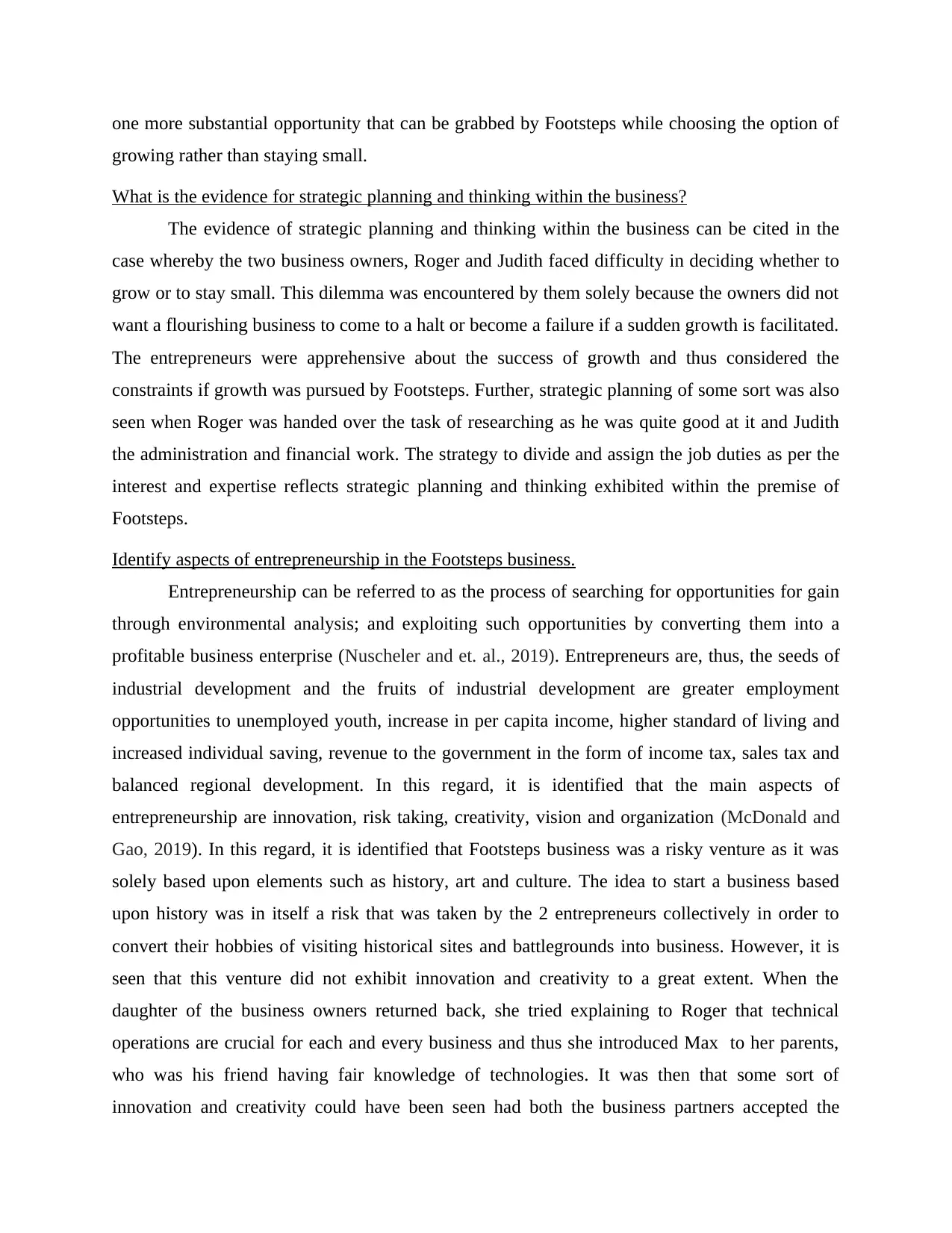
one more substantial opportunity that can be grabbed by Footsteps while choosing the option of
growing rather than staying small.
What is the evidence for strategic planning and thinking within the business?
The evidence of strategic planning and thinking within the business can be cited in the
case whereby the two business owners, Roger and Judith faced difficulty in deciding whether to
grow or to stay small. This dilemma was encountered by them solely because the owners did not
want a flourishing business to come to a halt or become a failure if a sudden growth is facilitated.
The entrepreneurs were apprehensive about the success of growth and thus considered the
constraints if growth was pursued by Footsteps. Further, strategic planning of some sort was also
seen when Roger was handed over the task of researching as he was quite good at it and Judith
the administration and financial work. The strategy to divide and assign the job duties as per the
interest and expertise reflects strategic planning and thinking exhibited within the premise of
Footsteps.
Identify aspects of entrepreneurship in the Footsteps business.
Entrepreneurship can be referred to as the process of searching for opportunities for gain
through environmental analysis; and exploiting such opportunities by converting them into a
profitable business enterprise (Nuscheler and et. al., 2019). Entrepreneurs are, thus, the seeds of
industrial development and the fruits of industrial development are greater employment
opportunities to unemployed youth, increase in per capita income, higher standard of living and
increased individual saving, revenue to the government in the form of income tax, sales tax and
balanced regional development. In this regard, it is identified that the main aspects of
entrepreneurship are innovation, risk taking, creativity, vision and organization (McDonald and
Gao, 2019). In this regard, it is identified that Footsteps business was a risky venture as it was
solely based upon elements such as history, art and culture. The idea to start a business based
upon history was in itself a risk that was taken by the 2 entrepreneurs collectively in order to
convert their hobbies of visiting historical sites and battlegrounds into business. However, it is
seen that this venture did not exhibit innovation and creativity to a great extent. When the
daughter of the business owners returned back, she tried explaining to Roger that technical
operations are crucial for each and every business and thus she introduced Max to her parents,
who was his friend having fair knowledge of technologies. It was then that some sort of
innovation and creativity could have been seen had both the business partners accepted the
growing rather than staying small.
What is the evidence for strategic planning and thinking within the business?
The evidence of strategic planning and thinking within the business can be cited in the
case whereby the two business owners, Roger and Judith faced difficulty in deciding whether to
grow or to stay small. This dilemma was encountered by them solely because the owners did not
want a flourishing business to come to a halt or become a failure if a sudden growth is facilitated.
The entrepreneurs were apprehensive about the success of growth and thus considered the
constraints if growth was pursued by Footsteps. Further, strategic planning of some sort was also
seen when Roger was handed over the task of researching as he was quite good at it and Judith
the administration and financial work. The strategy to divide and assign the job duties as per the
interest and expertise reflects strategic planning and thinking exhibited within the premise of
Footsteps.
Identify aspects of entrepreneurship in the Footsteps business.
Entrepreneurship can be referred to as the process of searching for opportunities for gain
through environmental analysis; and exploiting such opportunities by converting them into a
profitable business enterprise (Nuscheler and et. al., 2019). Entrepreneurs are, thus, the seeds of
industrial development and the fruits of industrial development are greater employment
opportunities to unemployed youth, increase in per capita income, higher standard of living and
increased individual saving, revenue to the government in the form of income tax, sales tax and
balanced regional development. In this regard, it is identified that the main aspects of
entrepreneurship are innovation, risk taking, creativity, vision and organization (McDonald and
Gao, 2019). In this regard, it is identified that Footsteps business was a risky venture as it was
solely based upon elements such as history, art and culture. The idea to start a business based
upon history was in itself a risk that was taken by the 2 entrepreneurs collectively in order to
convert their hobbies of visiting historical sites and battlegrounds into business. However, it is
seen that this venture did not exhibit innovation and creativity to a great extent. When the
daughter of the business owners returned back, she tried explaining to Roger that technical
operations are crucial for each and every business and thus she introduced Max to her parents,
who was his friend having fair knowledge of technologies. It was then that some sort of
innovation and creativity could have been seen had both the business partners accepted the
Paraphrase This Document
Need a fresh take? Get an instant paraphrase of this document with our AI Paraphraser
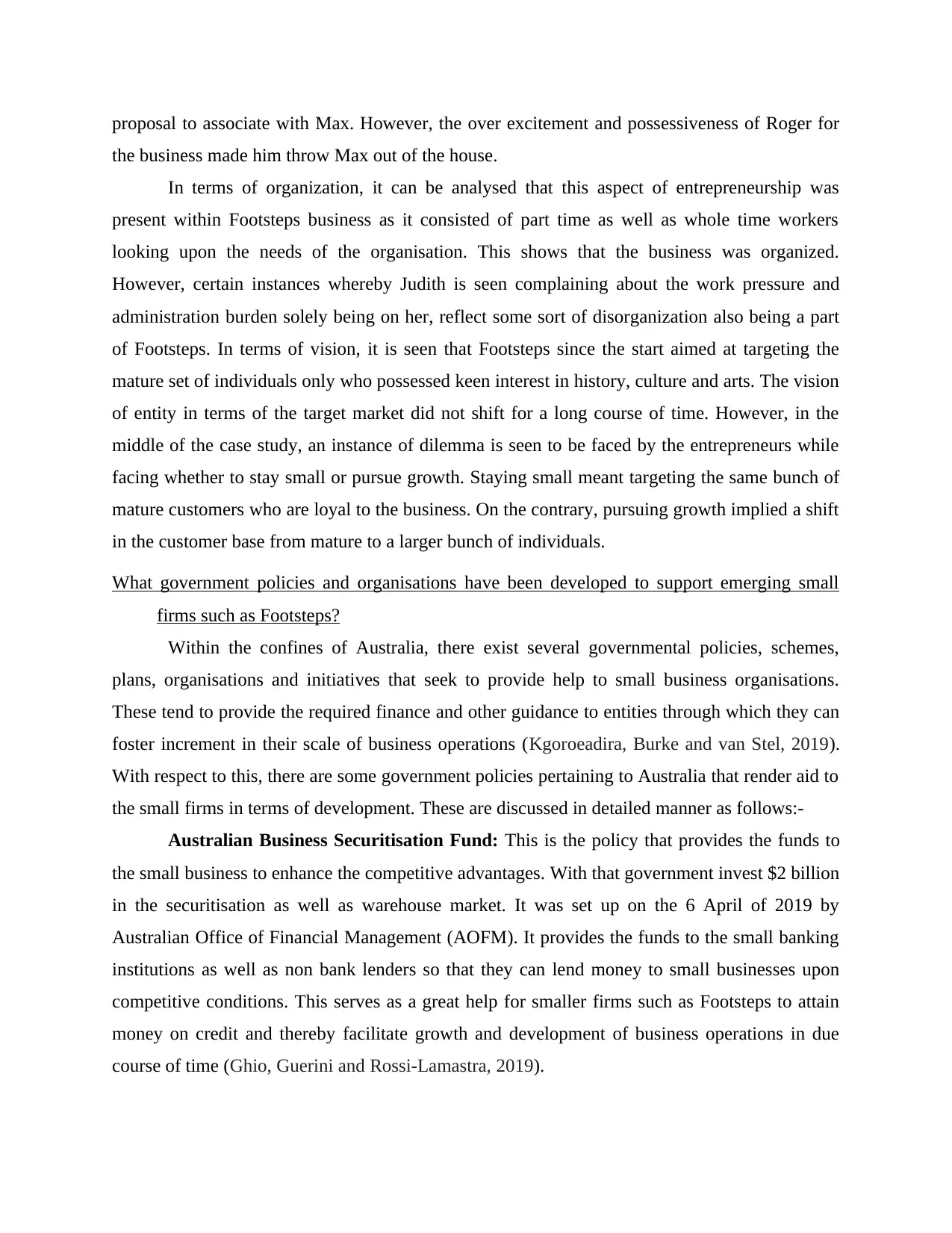
proposal to associate with Max. However, the over excitement and possessiveness of Roger for
the business made him throw Max out of the house.
In terms of organization, it can be analysed that this aspect of entrepreneurship was
present within Footsteps business as it consisted of part time as well as whole time workers
looking upon the needs of the organisation. This shows that the business was organized.
However, certain instances whereby Judith is seen complaining about the work pressure and
administration burden solely being on her, reflect some sort of disorganization also being a part
of Footsteps. In terms of vision, it is seen that Footsteps since the start aimed at targeting the
mature set of individuals only who possessed keen interest in history, culture and arts. The vision
of entity in terms of the target market did not shift for a long course of time. However, in the
middle of the case study, an instance of dilemma is seen to be faced by the entrepreneurs while
facing whether to stay small or pursue growth. Staying small meant targeting the same bunch of
mature customers who are loyal to the business. On the contrary, pursuing growth implied a shift
in the customer base from mature to a larger bunch of individuals.
What government policies and organisations have been developed to support emerging small
firms such as Footsteps?
Within the confines of Australia, there exist several governmental policies, schemes,
plans, organisations and initiatives that seek to provide help to small business organisations.
These tend to provide the required finance and other guidance to entities through which they can
foster increment in their scale of business operations (Kgoroeadira, Burke and van Stel, 2019).
With respect to this, there are some government policies pertaining to Australia that render aid to
the small firms in terms of development. These are discussed in detailed manner as follows:-
Australian Business Securitisation Fund: This is the policy that provides the funds to
the small business to enhance the competitive advantages. With that government invest $2 billion
in the securitisation as well as warehouse market. It was set up on the 6 April of 2019 by
Australian Office of Financial Management (AOFM). It provides the funds to the small banking
institutions as well as non bank lenders so that they can lend money to small businesses upon
competitive conditions. This serves as a great help for smaller firms such as Footsteps to attain
money on credit and thereby facilitate growth and development of business operations in due
course of time (Ghio, Guerini and Rossi-Lamastra, 2019).
the business made him throw Max out of the house.
In terms of organization, it can be analysed that this aspect of entrepreneurship was
present within Footsteps business as it consisted of part time as well as whole time workers
looking upon the needs of the organisation. This shows that the business was organized.
However, certain instances whereby Judith is seen complaining about the work pressure and
administration burden solely being on her, reflect some sort of disorganization also being a part
of Footsteps. In terms of vision, it is seen that Footsteps since the start aimed at targeting the
mature set of individuals only who possessed keen interest in history, culture and arts. The vision
of entity in terms of the target market did not shift for a long course of time. However, in the
middle of the case study, an instance of dilemma is seen to be faced by the entrepreneurs while
facing whether to stay small or pursue growth. Staying small meant targeting the same bunch of
mature customers who are loyal to the business. On the contrary, pursuing growth implied a shift
in the customer base from mature to a larger bunch of individuals.
What government policies and organisations have been developed to support emerging small
firms such as Footsteps?
Within the confines of Australia, there exist several governmental policies, schemes,
plans, organisations and initiatives that seek to provide help to small business organisations.
These tend to provide the required finance and other guidance to entities through which they can
foster increment in their scale of business operations (Kgoroeadira, Burke and van Stel, 2019).
With respect to this, there are some government policies pertaining to Australia that render aid to
the small firms in terms of development. These are discussed in detailed manner as follows:-
Australian Business Securitisation Fund: This is the policy that provides the funds to
the small business to enhance the competitive advantages. With that government invest $2 billion
in the securitisation as well as warehouse market. It was set up on the 6 April of 2019 by
Australian Office of Financial Management (AOFM). It provides the funds to the small banking
institutions as well as non bank lenders so that they can lend money to small businesses upon
competitive conditions. This serves as a great help for smaller firms such as Footsteps to attain
money on credit and thereby facilitate growth and development of business operations in due
course of time (Ghio, Guerini and Rossi-Lamastra, 2019).
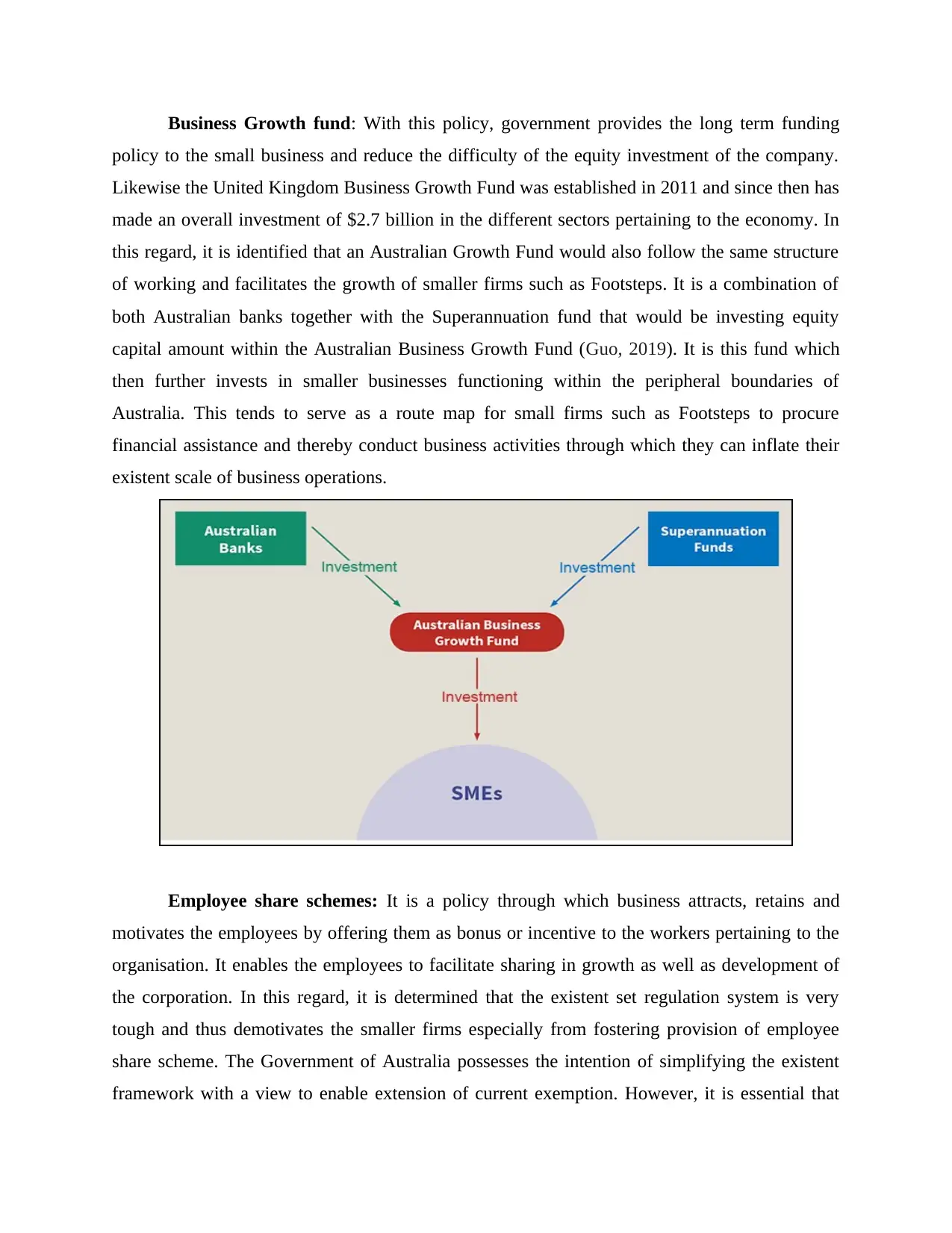
Business Growth fund: With this policy, government provides the long term funding
policy to the small business and reduce the difficulty of the equity investment of the company.
Likewise the United Kingdom Business Growth Fund was established in 2011 and since then has
made an overall investment of $2.7 billion in the different sectors pertaining to the economy. In
this regard, it is identified that an Australian Growth Fund would also follow the same structure
of working and facilitates the growth of smaller firms such as Footsteps. It is a combination of
both Australian banks together with the Superannuation fund that would be investing equity
capital amount within the Australian Business Growth Fund (Guo, 2019). It is this fund which
then further invests in smaller businesses functioning within the peripheral boundaries of
Australia. This tends to serve as a route map for small firms such as Footsteps to procure
financial assistance and thereby conduct business activities through which they can inflate their
existent scale of business operations.
Employee share schemes: It is a policy through which business attracts, retains and
motivates the employees by offering them as bonus or incentive to the workers pertaining to the
organisation. It enables the employees to facilitate sharing in growth as well as development of
the corporation. In this regard, it is determined that the existent set regulation system is very
tough and thus demotivates the smaller firms especially from fostering provision of employee
share scheme. The Government of Australia possesses the intention of simplifying the existent
framework with a view to enable extension of current exemption. However, it is essential that
policy to the small business and reduce the difficulty of the equity investment of the company.
Likewise the United Kingdom Business Growth Fund was established in 2011 and since then has
made an overall investment of $2.7 billion in the different sectors pertaining to the economy. In
this regard, it is identified that an Australian Growth Fund would also follow the same structure
of working and facilitates the growth of smaller firms such as Footsteps. It is a combination of
both Australian banks together with the Superannuation fund that would be investing equity
capital amount within the Australian Business Growth Fund (Guo, 2019). It is this fund which
then further invests in smaller businesses functioning within the peripheral boundaries of
Australia. This tends to serve as a route map for small firms such as Footsteps to procure
financial assistance and thereby conduct business activities through which they can inflate their
existent scale of business operations.
Employee share schemes: It is a policy through which business attracts, retains and
motivates the employees by offering them as bonus or incentive to the workers pertaining to the
organisation. It enables the employees to facilitate sharing in growth as well as development of
the corporation. In this regard, it is determined that the existent set regulation system is very
tough and thus demotivates the smaller firms especially from fostering provision of employee
share scheme. The Government of Australia possesses the intention of simplifying the existent
framework with a view to enable extension of current exemption. However, it is essential that
⊘ This is a preview!⊘
Do you want full access?
Subscribe today to unlock all pages.

Trusted by 1+ million students worldwide
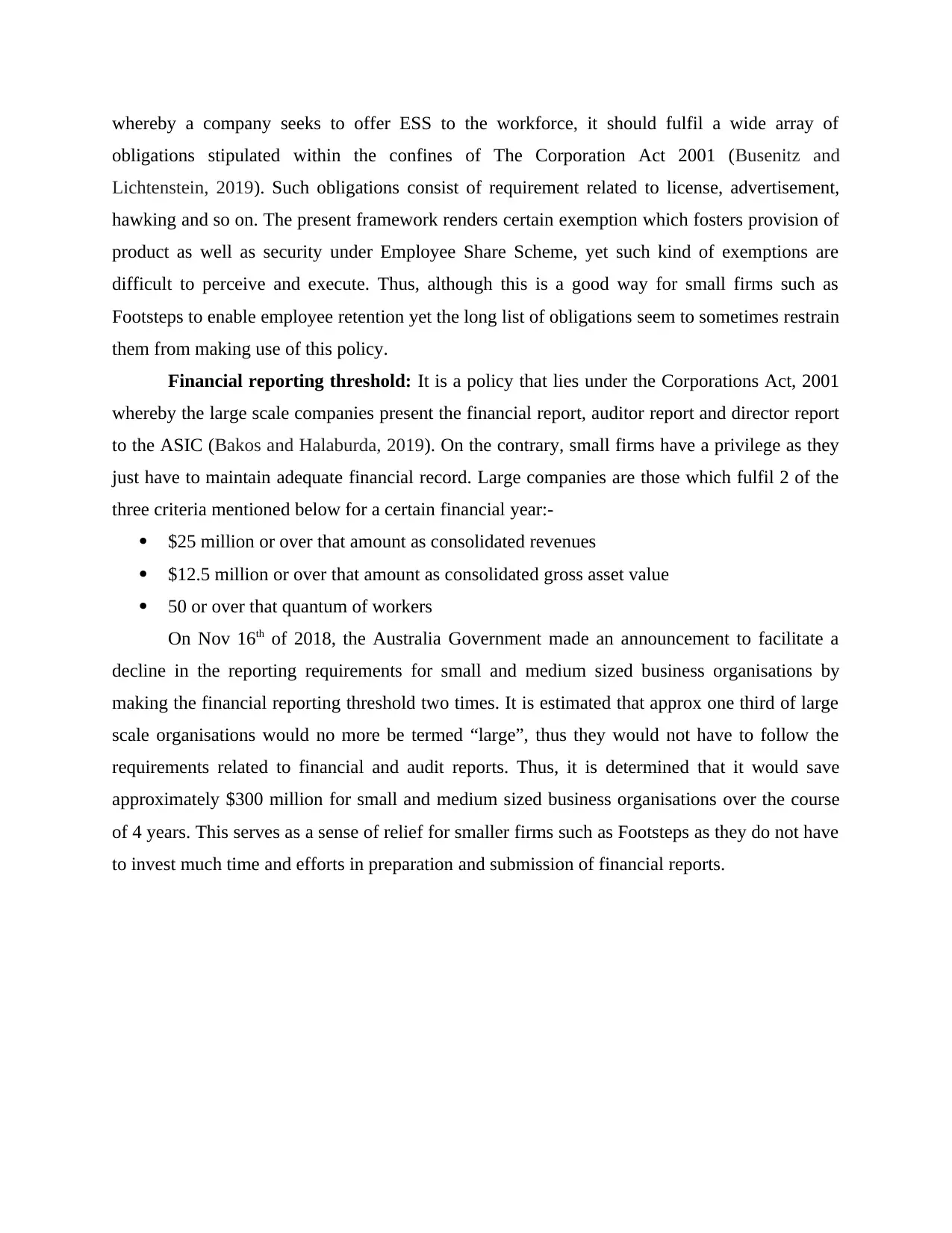
whereby a company seeks to offer ESS to the workforce, it should fulfil a wide array of
obligations stipulated within the confines of The Corporation Act 2001 (Busenitz and
Lichtenstein, 2019). Such obligations consist of requirement related to license, advertisement,
hawking and so on. The present framework renders certain exemption which fosters provision of
product as well as security under Employee Share Scheme, yet such kind of exemptions are
difficult to perceive and execute. Thus, although this is a good way for small firms such as
Footsteps to enable employee retention yet the long list of obligations seem to sometimes restrain
them from making use of this policy.
Financial reporting threshold: It is a policy that lies under the Corporations Act, 2001
whereby the large scale companies present the financial report, auditor report and director report
to the ASIC (Bakos and Halaburda, 2019). On the contrary, small firms have a privilege as they
just have to maintain adequate financial record. Large companies are those which fulfil 2 of the
three criteria mentioned below for a certain financial year:-
$25 million or over that amount as consolidated revenues
$12.5 million or over that amount as consolidated gross asset value
50 or over that quantum of workers
On Nov 16th of 2018, the Australia Government made an announcement to facilitate a
decline in the reporting requirements for small and medium sized business organisations by
making the financial reporting threshold two times. It is estimated that approx one third of large
scale organisations would no more be termed “large”, thus they would not have to follow the
requirements related to financial and audit reports. Thus, it is determined that it would save
approximately $300 million for small and medium sized business organisations over the course
of 4 years. This serves as a sense of relief for smaller firms such as Footsteps as they do not have
to invest much time and efforts in preparation and submission of financial reports.
obligations stipulated within the confines of The Corporation Act 2001 (Busenitz and
Lichtenstein, 2019). Such obligations consist of requirement related to license, advertisement,
hawking and so on. The present framework renders certain exemption which fosters provision of
product as well as security under Employee Share Scheme, yet such kind of exemptions are
difficult to perceive and execute. Thus, although this is a good way for small firms such as
Footsteps to enable employee retention yet the long list of obligations seem to sometimes restrain
them from making use of this policy.
Financial reporting threshold: It is a policy that lies under the Corporations Act, 2001
whereby the large scale companies present the financial report, auditor report and director report
to the ASIC (Bakos and Halaburda, 2019). On the contrary, small firms have a privilege as they
just have to maintain adequate financial record. Large companies are those which fulfil 2 of the
three criteria mentioned below for a certain financial year:-
$25 million or over that amount as consolidated revenues
$12.5 million or over that amount as consolidated gross asset value
50 or over that quantum of workers
On Nov 16th of 2018, the Australia Government made an announcement to facilitate a
decline in the reporting requirements for small and medium sized business organisations by
making the financial reporting threshold two times. It is estimated that approx one third of large
scale organisations would no more be termed “large”, thus they would not have to follow the
requirements related to financial and audit reports. Thus, it is determined that it would save
approximately $300 million for small and medium sized business organisations over the course
of 4 years. This serves as a sense of relief for smaller firms such as Footsteps as they do not have
to invest much time and efforts in preparation and submission of financial reports.
Paraphrase This Document
Need a fresh take? Get an instant paraphrase of this document with our AI Paraphraser
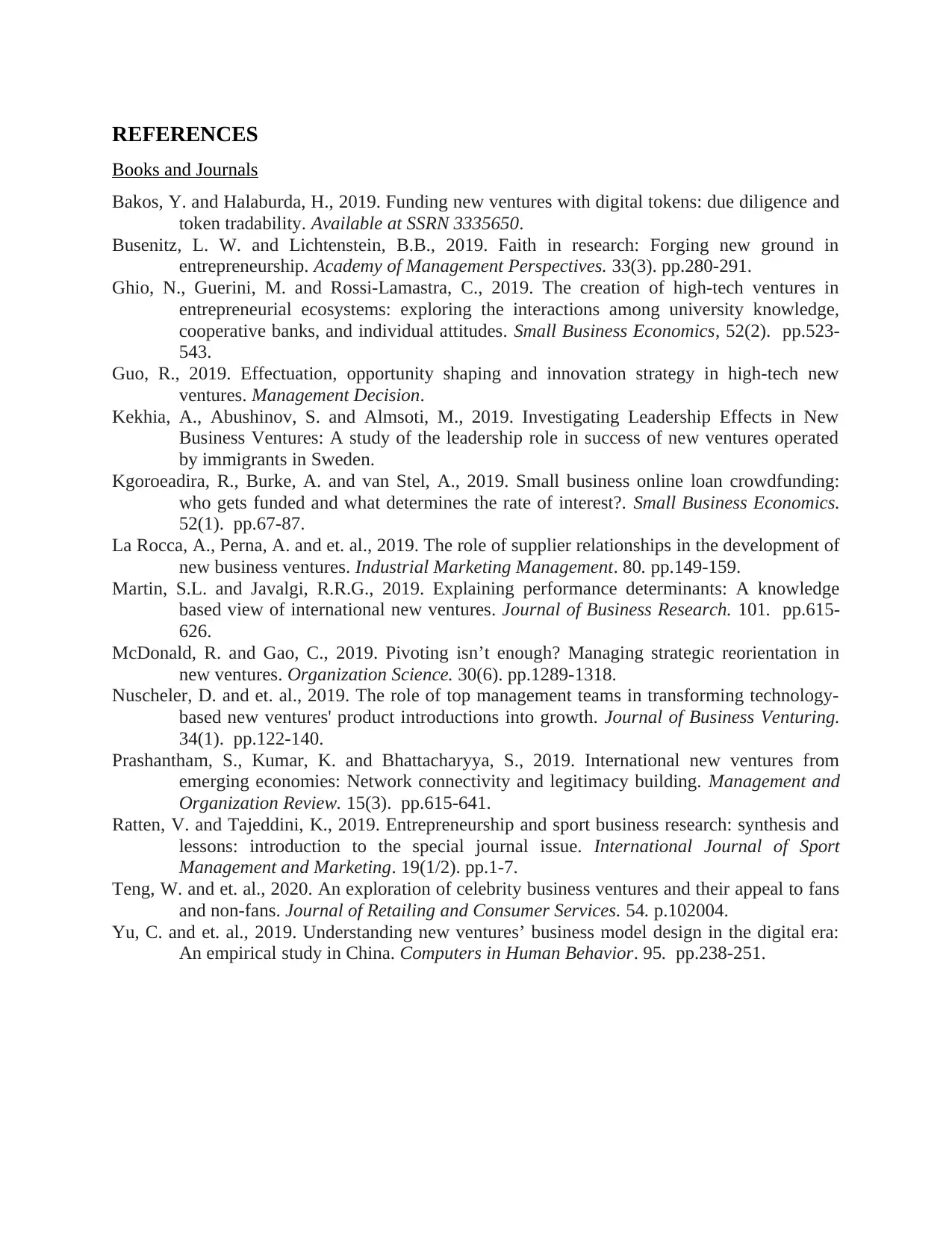
REFERENCES
Books and Journals
Bakos, Y. and Halaburda, H., 2019. Funding new ventures with digital tokens: due diligence and
token tradability. Available at SSRN 3335650.
Busenitz, L. W. and Lichtenstein, B.B., 2019. Faith in research: Forging new ground in
entrepreneurship. Academy of Management Perspectives. 33(3). pp.280-291.
Ghio, N., Guerini, M. and Rossi-Lamastra, C., 2019. The creation of high-tech ventures in
entrepreneurial ecosystems: exploring the interactions among university knowledge,
cooperative banks, and individual attitudes. Small Business Economics, 52(2). pp.523-
543.
Guo, R., 2019. Effectuation, opportunity shaping and innovation strategy in high-tech new
ventures. Management Decision.
Kekhia, A., Abushinov, S. and Almsoti, M., 2019. Investigating Leadership Effects in New
Business Ventures: A study of the leadership role in success of new ventures operated
by immigrants in Sweden.
Kgoroeadira, R., Burke, A. and van Stel, A., 2019. Small business online loan crowdfunding:
who gets funded and what determines the rate of interest?. Small Business Economics.
52(1). pp.67-87.
La Rocca, A., Perna, A. and et. al., 2019. The role of supplier relationships in the development of
new business ventures. Industrial Marketing Management. 80. pp.149-159.
Martin, S.L. and Javalgi, R.R.G., 2019. Explaining performance determinants: A knowledge
based view of international new ventures. Journal of Business Research. 101. pp.615-
626.
McDonald, R. and Gao, C., 2019. Pivoting isn’t enough? Managing strategic reorientation in
new ventures. Organization Science. 30(6). pp.1289-1318.
Nuscheler, D. and et. al., 2019. The role of top management teams in transforming technology-
based new ventures' product introductions into growth. Journal of Business Venturing.
34(1). pp.122-140.
Prashantham, S., Kumar, K. and Bhattacharyya, S., 2019. International new ventures from
emerging economies: Network connectivity and legitimacy building. Management and
Organization Review. 15(3). pp.615-641.
Ratten, V. and Tajeddini, K., 2019. Entrepreneurship and sport business research: synthesis and
lessons: introduction to the special journal issue. International Journal of Sport
Management and Marketing. 19(1/2). pp.1-7.
Teng, W. and et. al., 2020. An exploration of celebrity business ventures and their appeal to fans
and non-fans. Journal of Retailing and Consumer Services. 54. p.102004.
Yu, C. and et. al., 2019. Understanding new ventures’ business model design in the digital era:
An empirical study in China. Computers in Human Behavior. 95. pp.238-251.
Books and Journals
Bakos, Y. and Halaburda, H., 2019. Funding new ventures with digital tokens: due diligence and
token tradability. Available at SSRN 3335650.
Busenitz, L. W. and Lichtenstein, B.B., 2019. Faith in research: Forging new ground in
entrepreneurship. Academy of Management Perspectives. 33(3). pp.280-291.
Ghio, N., Guerini, M. and Rossi-Lamastra, C., 2019. The creation of high-tech ventures in
entrepreneurial ecosystems: exploring the interactions among university knowledge,
cooperative banks, and individual attitudes. Small Business Economics, 52(2). pp.523-
543.
Guo, R., 2019. Effectuation, opportunity shaping and innovation strategy in high-tech new
ventures. Management Decision.
Kekhia, A., Abushinov, S. and Almsoti, M., 2019. Investigating Leadership Effects in New
Business Ventures: A study of the leadership role in success of new ventures operated
by immigrants in Sweden.
Kgoroeadira, R., Burke, A. and van Stel, A., 2019. Small business online loan crowdfunding:
who gets funded and what determines the rate of interest?. Small Business Economics.
52(1). pp.67-87.
La Rocca, A., Perna, A. and et. al., 2019. The role of supplier relationships in the development of
new business ventures. Industrial Marketing Management. 80. pp.149-159.
Martin, S.L. and Javalgi, R.R.G., 2019. Explaining performance determinants: A knowledge
based view of international new ventures. Journal of Business Research. 101. pp.615-
626.
McDonald, R. and Gao, C., 2019. Pivoting isn’t enough? Managing strategic reorientation in
new ventures. Organization Science. 30(6). pp.1289-1318.
Nuscheler, D. and et. al., 2019. The role of top management teams in transforming technology-
based new ventures' product introductions into growth. Journal of Business Venturing.
34(1). pp.122-140.
Prashantham, S., Kumar, K. and Bhattacharyya, S., 2019. International new ventures from
emerging economies: Network connectivity and legitimacy building. Management and
Organization Review. 15(3). pp.615-641.
Ratten, V. and Tajeddini, K., 2019. Entrepreneurship and sport business research: synthesis and
lessons: introduction to the special journal issue. International Journal of Sport
Management and Marketing. 19(1/2). pp.1-7.
Teng, W. and et. al., 2020. An exploration of celebrity business ventures and their appeal to fans
and non-fans. Journal of Retailing and Consumer Services. 54. p.102004.
Yu, C. and et. al., 2019. Understanding new ventures’ business model design in the digital era:
An empirical study in China. Computers in Human Behavior. 95. pp.238-251.
1 out of 11
Related Documents
Your All-in-One AI-Powered Toolkit for Academic Success.
+13062052269
info@desklib.com
Available 24*7 on WhatsApp / Email
![[object Object]](/_next/static/media/star-bottom.7253800d.svg)
Unlock your academic potential
Copyright © 2020–2025 A2Z Services. All Rights Reserved. Developed and managed by ZUCOL.




